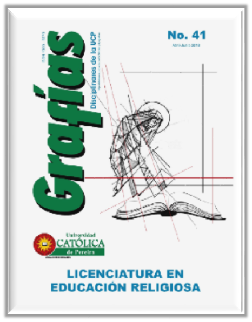Base components for building significant learning
DOI:
https://doi.org/10.31908/grafias.v0i41.1173Keywords:
Constructivism, significant learning, Bachelor of Religious Education, teaching, knowingAbstract
This paper presents the construction of student learning of the Bachelor of Religious Education, identifying in significant learning the bases for such construction in integration of different disciplines such as psychology, pedagogy, philosophy and oral and written expression as meeting point. The question about knowledge is addressed by showing how the human being maintains this concern and how the undergraduate student manages to solve this question and to be comprehensively trained. In this process the questions about what and how to learn? and how to build? will be fundamental.
References
Cassany, D. (2002). Alfabetización digital.Disponible en
Casttell , M. (2005). Sociedad de lainformación y sociedad del conocimiento.Disponible en http://www.ub.edu/prometheus21/articulos/obsciberprome/socinfsoccon.pdf
Coll, C. y Solé, I. (2001). Aprendizajesignificativo y ayuda pedagógica. Candidus,15. Disponible enhttp://www.quadernsdigitals.net/datos_web/hemeroteca/r_38/nr_398/a_5480/5480.htm(29 Agosto 2016)
Gevaert, J. (1976). El problema del hombre.Introducción a la antropología filosófica.Salamanca: Sígueme.
Hipona, A. (2016). Confesiones de sanAgustín: Sermón XLIIITrad. Pedro deRibadeneyra. Burgos: Autores Cristianos.Husserl, E. (1980). Vorlezungenzur Phanamenologie des innerenZeitbewusstseins. Trad. Agustín Serrano deHaro. Madrid: Trotta.
Lucas, Juan de Sahagún (1996). Lasdimensiones del hombre: Antropologíafilosófica. Salamanca: Sígueme.
Mercer, N. (1997). Construcción Guiada delConocimiento. Disponible en http://s3.amazonaws.com/academia.edu.documents/8572275/neilmercer-_la_construccion_guiada_del_conocimiento.p d f ? AW S A c c e s s K e y I d=A K I A J 5 6 TQ J RT W S M T N P E A & E x p i r e s=1 4 7 0 28 9 1 8 6 & S i g n a t u r e=L 3 3 h g G r r 9 O n J F v E I WA 4 u T p i 6 k 9 M % 3 D & r e s p o n s e -content-disposition=inline%3B%20filename%3DLa_construccion_guiada_del_conocimiento.pdf (26 Agosto 2016)
Vigotsky, L. (1979). El desarrollo delos procesos psicológicos superiores.Disponible en http://www.amnweb.org/uploads/8/2/6/7/8267504/vygotsky_-_el_desarrollo_de_los_procesos_psicologicos_superiores.pdf


